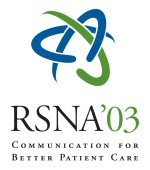
Abstract Archives of the RSNA, 2003
Q16-1336
A Consideration of Artificial Images for Classifying Diffuse Lung Opacities in Thin-section Computed Tomography Images
Scientific Papers
Presented on December 4, 2003
Presented as part of Q16: Physics (CAD VIII: Thoracic CT, Others)
Yoshihiro Mitani PhD, PRESENTER: Nothing to Disclose
Abstract:
HTML
Purpose: The classification of diffuse lung opacities in thin-section computed tomography(HRCT) images with high accuracy is very fundamental for designing a computer-aided diagnosis(CAD) system. In this paper, we discuss the use of artificial images for designing a CAD system.
Methods and Materials: The HRCT images(512x512 pixels, 12bits/pixel, 0.35mm/pixel) were obtained from 11 patients with a variety of diffuse lung diseases. In the HRCT images, we selected 500 23x23-sized regions of interest(ROIs) with 4 classes of typical diffuse lung opacities(reticular, nodular, ground-glass, and consolidation) and one normal class. These are considered to be textures. Moreover, there are no textural orientations. This means that the region of deseases is independent of orientations. In designing a CAD system, the number of the training samples is usually small. This leads to the difficulties of designing a classifier. Therefore, we consider the use of artificial images generated by rotation and reversal. In generating the artificial images by rotation, we have proposed the followings. We firstly prepared a 47x47-sized array and put the original ROI into the central of the array. Secondly, we generated a seemless texture by symmetrizing the boundaries of the original ROI. Thirdly, the array was rotated, and the uncovered pixels were input by averaging the neighborhoods. Finally, a 23x23-sized ROI was extracted from the central of the array. The Gabor features, which produce a good performance in texture recognition, were extracted from the ROIs. In the experiments, 500 available samples were randomly divided into 250 training and test samples. And, the error rate for the test samples was estimated by the nearest neighbor classifier. These were independently repeated 100 times, and the average and 95% confidence interval of the error rate were computed.
Results: The artificial images by the combination of the rotation and reversal were generated. In the rotation, we generated the artificial image every one degree. The error rates with the artificial and original images were 4.50+/-0.18 and 7.71+/-0.31, respectively. This shows the effectiveness of using the artificial images.
Conclusion: In order to overcome the small sample size problem, the use of the artificial images has been considered. Experimental results show the effectiveness of our approach.
Questions about this event email: mitani@yamaguchi-jc.ac.jp
Mitani PhD, Y,
A Consideration of Artificial Images for Classifying Diffuse Lung Opacities in Thin-section Computed Tomography Images. Radiological Society of North America 2003 Scientific Assembly and Annual Meeting, November 30 - December 5, 2003 ,Chicago IL.
http://archive.rsna.org/2003/3103113.html

